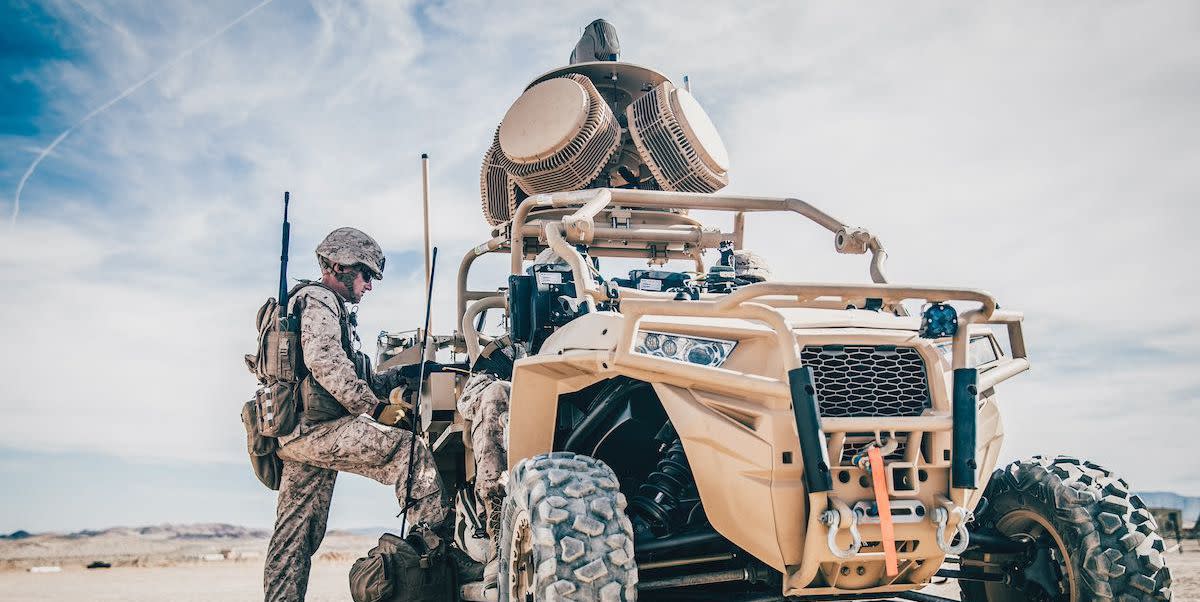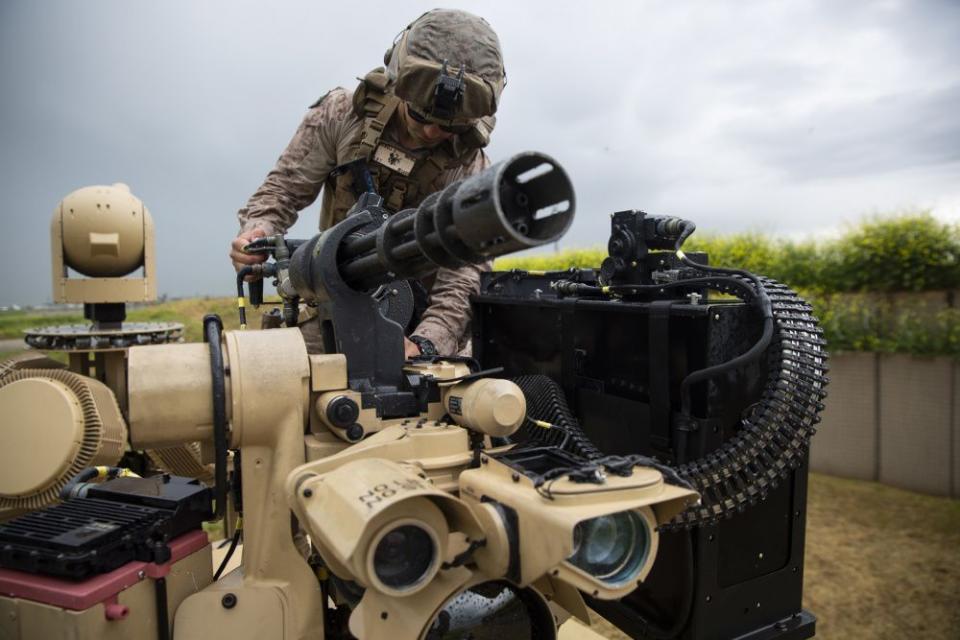This Is the ATV-Mounted Jammer That Took Down an Iranian Drone

The U.S. Marine Corps used a new portable jammer system last week to jam an Iranian unmanned aerial vehicle, forcing it to pitch into the sea. The new Light Marine Air Defense Integrated System (LMADIS) jams the signal between drones and their operators, leaving them at the mercy of physics, and inevitably, gravity.
The incident took place in the Strait of Hormuz, which connects the Gulf of Oman to the Persian Gulf. The 11th Marine Expeditionary Unit, embarked on the amphibious assault ship Boxer, parked a LMADIS jammer on the Boxer’s flight deck to provide a defense against Iranian UAVs known to operate in the area. The marines detected an Iranian unmanned aerial vehicle and jammed it when the drone closed to within 1,000 yards of the Boxer.

LMADIS is a counter unmanned aerial system (counter-UAS) weapon consisting of two Polaris MRZR scooters: a command vehicle and a jamming vehicle. According to a C4ISRNet article from earlier this year, LMADIS consists of a “RPS-42 tactical air surveillance radar, small EO/IR camera, Skyview RF Detection system and Sierra Nevada MODi RF jammer”.
LMADIS engagement procedure goes something like this: the RPS-42 detects the drone on radar, or alternately Skyview detects the back-and-forth radio signals between the drone operators and the drone itself. Next, the electro-optical/infrared camera is trained on the incoming drone to make a positive identification as friendly or hostile. If hostile, the Marines aim the MODi jammer at the drone and prevent the drone operators’ radio commands from reaching it. Gravity takes care of the rest.
The Iranian footage clearly shows the Light Marine Air Defense Integrated System (LMADIS) deployed aboard the USS Boxer, which indicate that the footage are not old. pic.twitter.com/qstV22zG4N
— Within Syria (@WithinSyriaBlog) July 19, 2019
The LMADIS vehicle was parked on the bow of the Boxer and was even caught on camera by another Iranian drone on a reconnaissance flight. Iranian forces seemingly failed to assess LMADIS as a threat to their drone, despite the system being shown on U.S. military social media sites on the decks of other navy ships operating in the Middle East.
The MODi jammer was tested against a variety of civilian drones, including the DJI Phantom 4 Pro, X8 fixed wing, and Airhawk. The C4ISRNet article quotes the program manager for LMADIS as stating “what we’ve realized is the UAS threat is ever-changing. One day the enemy’s flying Phantom Pros, the next day they’re flying a fixed wing with certain components. What the fleet’s really helping us identify is what they’re flying and how to defeat them, so we can turn back to the fleet and give them a better product to stay up to date with the enemy’s current threats.”
The Iranian drone was almost certainly bigger than a commercial hobbyist drone. According to a Pentagon spokesperson quoted by NPR, the drone was a "fixed wing unmanned aerial system (UAS)." It could have been one of Iran’s Mohajer series of drones.
About type of Iranian UAV. I'm inclined to this variant of Mohajer-4B om 2 photo. Iran also have another UAVs with skids, for example the Shahed-121 (3) and Mohajed-2\2N (4), but IMHO skids there are a little different. In any case, it was definitely one of the tactical recc UAVs pic.twitter.com/d1Pz0VE2vu
— Yuri Lyamin (@imp_navigator) July 19, 2019
Iran claims the drone was a Mohajer-4 but also claims the drone was not downed.
While both the commercial civilian drones LMADIS was tested on and Iran’s military drones likely use the same control systems and frequencies, it’s interesting that the U.S. seemingly played down the jammer’s capabilities, mentioning it had been tested only against civilian drones.
The broader Marine Air Defense Integrated System is meant to shoot down drones, fixed-wing aircraft, and helicopters and includes both non-kinetic (jamming) and kinetic weapons to down drones. The kinetic weapon is a 7.62-millimeter minigun mounted on the new Humvee replacement, the Joint Light Tactical Vehicle. The Marine Corps plans to eventually add laser weapons to LMADIS.

LMADIS is a part of the Marine Corps air defense artillery branch and is part of a broader effort to re-establish short range air defenses. While America’s overwhelming advantage in airpower has historically made U.S. ground forces safe from air attack, the proliferation of drones as weapons of war has created a weapon that could easily sneak under a patrol of F-35 fighters to attack Marines on the ground.
The use of drones by groups such as ISIS, smaller powers such as Iran, and even Russia and China make an air defense system that can shoot down everything from commercial drones to enemy attack helicopters and fighter jets an imperative.
You Might Also Like

 Yahoo News
Yahoo News 
